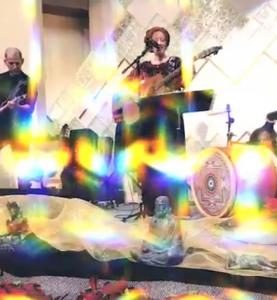 The Church is dying. Specifically, Christianity in Western countries is rapidly diminishing. 7-8,000 churches close their doors every year in the U.S. – about 150-200 every week. In 1966, there were 600 Catholic seminaries in America. 189 remain. 1000 Southern Baptist congregations close every year with half of them predicted to close by 2030. More and more churches are seeing fewer people participating in worship services and the ones who do are attending less frequently. Sure, there are a few exceptional congregations here and there, but they are outliers and those too will be declining within 10 years or so. Some say way we need to reform Christianity. Some say we need to do church differently. Some say we need to revise the language. Some say we need to jettison Christianity and the Church that conveys and enfleshes it all together.
The Church is dying. Specifically, Christianity in Western countries is rapidly diminishing. 7-8,000 churches close their doors every year in the U.S. – about 150-200 every week. In 1966, there were 600 Catholic seminaries in America. 189 remain. 1000 Southern Baptist congregations close every year with half of them predicted to close by 2030. More and more churches are seeing fewer people participating in worship services and the ones who do are attending less frequently. Sure, there are a few exceptional congregations here and there, but they are outliers and those too will be declining within 10 years or so. Some say way we need to reform Christianity. Some say we need to do church differently. Some say we need to revise the language. Some say we need to jettison Christianity and the Church that conveys and enfleshes it all together.
From moderate to radical, my colleagues Reverends Mark Sandlin and Greta Vosper, respectively, recently wrote essays conveying such calls to action in their recent columns on Progressing Spirit.
Here is how Sandlin closed his essay,
“We must recognize that we are now perfectly set up to not attract young adults and middle-aged folks. We are perfectly designed to get the results that we are getting. It’s going to take doing some things in radically new ways to turn the tides. We’ll have to embrace technology and social media more deeply than ever before. And, we will have to be intentional about breaking out of our routines. We will need to be deliberate about finding new ways to positively interact with younger folks. Nobody else can do it for us. There are no magical books or seminars that can make this easy. This is simply about the Church (remember, the people are the Church) breaking out of its safe routines and dogma, and deeply and lovingly engaging the community it is in.”
And her is how Vosper ended hers:
“There are good reasons not to resurrect participation in Christianity, most of which go to the troubling reinforcement of the prejudices of the Christian right through the continued use of the language of belief by the Christian left. But there are far more and better reasons to create or resurrect communities that act like church. We are not e.v.e.r. going to return to the kind of participation we enjoyed half a century ago; we shouldn’t even want to. But wherever we let our eyes linger, we see the need for work to be done that might make life more bearable for those in our own families of faith, our communities, our nations, and our world. We who do church know how that work can be done. With that knowledge, however, also comes the responsibility to do it.”
Both writers offer little in the way of concrete how tos, or specific “dos or don’ts.” There’s wisdom of course in being vague – as each congregation is in a unique context and setting. What may work in one community may not work in another. That said, I feel called to attempt to pick up the baton where they left off.
I too have offered vagueness in the past as I’ve observed these matters. Here’s the transcript of a talk I gave (and video) at the Christianity 21 Conference held in Phoenix a few years ago. You’ll note that while I convey a spirit of enthusiasm and hope, I offered little in the way of how the transformation of the Church will take place or what it might look like.
The Christian Church is profoundly diverse with some 20,000 different denominations and even more independent expressions. It will always remain a fact that different segments of our society will be at different places, embracing different perspectives. Thinkers such as James Fowler and Ken Wilber remind us of the many different ways people show up in their human and spiritual growth and development. There can be no “one size fits all” kind of church – let alone Christianity.
That said, I would submit that the primary reason people are eschewing so many churches – isn’t so much that they are rejecting all forms of “belief”, or all forms of Abrahamic monotheism, let alone all forms of theism. Sure, many educated, modern and post-modern minded people are understandably rejecting supernatural theism, but that is hardly the only form of theism within the faith. For instance, many progressive Christians embrace panentheism, and/or some form of process theology, openness, creation, or liberation theology. Most Christians, including many (and I think most) “spiritual but not religious” identified persons embrace some extent of an “I-Thou” – that there is a God, and we, while in truth are divine, aren’t the fullness or entirety of the Divine. That we aren’t all of God. That there is a certain something more that is greater than us, some holy Mystery, that is part of our reality – if not Is-ness itself. Now we might quibble about what degree of personhood, personality, aseity, agency, or volition this sacred deep reality may have, but most of us find value in prayer – even in the less “vocal” forms of prayer such as centering prayer, walking a labyrinth or out in nature, or meditation. Many if not most of us do those things with a profound sense of doing them “In the One in Whom we live, move, and have our being” (Paul, Acts 17:28). We aren’t alone in our efforts to be present to Presence.
That said, traditional/conventional churches have errored in overly emphasizing the transcendent aspects of God – “God’s wholly other, up there, in the sky/heaven far beyond us” – to the point where they have utterly forgotten the immanent parts of the Divine that are fully infused in all of Creation – including within each of us. The truth is, we can be awed by both.
I suggest that at least one major thing that the Church can and should be doing to be relevant to today’s Western society is to help people to experience God directly, to commune with Divine, and as part of that – to know and experience their own divinity. The following are 10 ways that churches can help foster environments that help facilitate this potential experience:
1. Adjust the Words so that The Word might be heard. Let’s face it, far too much of what is said in far too many church services is jargon that is unfamiliar to many people -and even offensive and off-putting. If people only hear God referred to with “He, Him, His” pronouns – this turns many completely off from even being willing to hear whatever else may be said. Too many of the traditional creeds employ archaic language and assert frankly unbelievable things if interpreted in a wooden, literal manner. So, if we do employ personified pronouns to refer to the Divine, let’s be willing to say “She, Her, Hers” at least as frequently. Or, let’s drop the gendered pronouns and simply say, “God’s love” etc. Let’s use alternative creeds and more contemporary affirmations of faith such as the Statements of Faith of the United Church of Canada, or of the Korean Methodist Church, etc. Let’s even be willing to “Change the Lord’s Prayer – Again.” And for goodness sake, let’s be willing to shed churchy terms such as “sanctuary, chancel, narthex,” etc. and refer to them instead as “worship center, stage, lobby,” etc. We don’t need any more stumbling blocks and barriers than there already are.
And if we do continue to use litanies, let’s use ones that are more relevant and on point with today’s needs.
Let’s also consider making the worship center less archaic and intimidating. More and more congregations are removing some or all of the pews and replacing them with comfy couches and cushioned recliners!
2. Put the Communing Back into Communion
Some may say, “there’s already the sacrament of Holy Communion that’s part of many church services!” Yes, however many churches only offer that once a month, and, while some of the faithful truly experience divine connection and grace in that sacrament, too often the possibility of feeling true connection is blocked – blocked by too much liturgy – a garble of (while perhaps beautifully written) rote words that are uber churchy and read dispassionately; and the sacrament is being offered in a perfunctory, institutional, and almost sterile manner. People dressed in suits and dresses, distributing stuff with an air of, “Next!”
What might work better is to not truncate and reduce the sacrament of communion such that it’s merely handing out tiny wafers of pinches of bread and token amounts of juice/wine. How about including foot-washing – or hand washing (or smartphone browser scrubbing) – each time we commune? That was just as much a part of what Jesus taught his disciples as the bread/wine. In fact, engaging such meaningful, intimate service may arguably be even more important than sharing the bread and juice. How about helping people to humbly tend to each other in a loving, intimate, and very present way? How about dropping all of the institutional “Great Thanksgiving” call and response, and just do as Jesus did – in the course of a meal (Agape Love Feast anyone? Can you say “Dinner Church”?). Sometimes less is more. Most times. It isn’t the fancy and long-winded verbosity of the Great Thanksgiving or the eloquent wording of the “words of institution” that are mysterious. I suggest that what helps people to experience Mystery is to say as little as possible and get right to the experience of people feeding each other broken bread and cup. Perhaps simply have someone rise and say in a down to earth, conversational way:
“Friends, on the night that Jesus was betrayed and arrested, he first met with his disciples, those closest to him, people who’d journeyed with him for 3 years, walking all over that country, witnessing him heal all sorts of people, and teaching them how to love deeply.. He shared a meal with them. He took some bread and he raised it, thanked God, (pregnant pause), and then he broke that bread saying – “Take. Eat. This is my body, broken for you!’ He then took the cup and gave thanks. Pause. And this too he shared with them saying, “This is my blood, my life force, my very essence, poured out for you. It’s the wine of a new covenant, for you and for many. It’s how much I really love you!’ Sisters and brothers, let us now serve each other in this great love. Let’s tap into that Cosmic Christ spirit and energy that surrounds us and connect, and commune, and tend to each other. This experience symbolizes how God turns brokenness into wholeness, and how we are to care for everyone out in the world all the time. All of our lives are called to be a sacrament. All of life is holy. Not just these few minutes at church. May we be reminded of this deeply as we commune with each other now…”
3. Drop the Exclusivism and Churchyness. ..and also drop the informal (but still very real) culture and ethos of which people are truly welcome at this church – and which ones aren’t. A felt sense of Exclusivism is one of the main reasons that many people are avoiding church these days. Incorporate wisdom nuggets, and parables, etc. from other faith traditions. The people showing up are already doing it, we may as well work with this and help people to connect the dots and get the most out of it.
4. Make space for Silence. The late, great Fr. Thomas Keating wrote that, “God’s first language is silence. Everything else is a translation.” If this is true, we’d do well to shut up more and let God speak. We do well to help people to “be still and know that God is God.” (Psalm 46:10). We do well to make space for intentional silence – centering prayer, meditation, or just silence for it’s own sake.
5. Free the Pulpit! Move away from preaching at people in a lecture hall, designated, guru manner, and instead seek to elicit and welcome the Shared Wisdom of the people participating! Doug Pagitt’s Solmon’s Porch congregation in Minneapolis (one of the first to get rid of pews and replace with couches) utilizes an organic, pop-corn style experience instead of a traditional sermon. There’s still a role for clergy, but the clergy need to let go of control! Controlling and controlled environments are off-putting to many people today. Sure, a certain amount of setting boundaries and expectations helps provide a healthy container that allows people to feel safe, but too much of that is dysfunctional and most people are allergic to it. Consider dropping the 3 point sermon, or expository preaching, and instead embrace poetry as sermon! Here’s an example of a poetry-sermon: “Wakey-Wakey!”
And here are two short spiritual poems I wrote that might be read in worship:
I. All Love
You yearn and burn and twist and turn
contentment always seeming just out of reach
Drop in.
Drop into the deep ocean of yourself
You’ve already got what you think you’re needing
All Love is there, it’s yours
as warm and nourishing as the blood pulsing through your veins
as inspire-ing as the air you breathe
as comforting as the song you hum as you fold the clothes
All Wisdom is within you
to sense as you need it.
Breathe deeply. Listen to your body. Embrace your animal. Trust your instinct.
Knead your paws into the lap of your soul
Take your time, relax,
and rest in the beauty of your kingdom.
Share it with others when you’re ready.
Let them enjoy their kingdoms that they see in yours.
They are one.
II. The Real You. You, the real you, knows the truth.
The Truth is you aren’t the things
that have happened to you..
You aren’t the things you’ve done..
You aren’t the things you failed to do..
You aren’t your wounds or the ones you inflicted..
Yon aren’t your regrets..
You aren’t in any way a should have,
could have, or would have..
You are fully human and fully divine
You a re the very incarnation of God.
No not the only one, but no less than one.
The unique prism of your life reminds us
of who we are too.
Thank you for your colors.
Thank you for your light.
Thank you for being
a stain-glass window picture story of glory.(art by Tara Turner, “The imagination of trees”)
If writing poetry isn’t within your current skill set, reading poems by Rumi, Gibran, John, O’Donohue, David Whyte, and Mary Oliver often works perfectly.
6. Incorporate and Embrace All the Senses. It really helps to have people not be sitting in one place for an hour or more. Instead, create worship services and rituals that have people moving to various worship stations to light candles, ring a bell after lighting them; writing in sand “writing their sins/dysfunctional patterns they wish to shed, and then practice wiping them away”; writing prayers on a chalk board; lighting incense (mild forms preferred as some people have asthma or other sensitivities; provide drums and rhythm makers for people to play along with for a song or two. Offer Communion every week and have people serve each other – very tactile. Provide coloring books with sacred art for people to draw on during the service, and perhaps post the created pieces they’ve colored onto an erected panel or wall before the final song is sung so people can enjoy who others helped co-create the shared experience!
7. Get people in their Bodies. Yes, you shouldn’t have to check your brain to enter a church, but there is merit in getting out of our heads some and more into our bodies. Invite people to drop in and feel the truth. Begin by having people feel their breath. Guide them in a Breath Prayer. Guide them in a Body Prayer. Guide them in a guided Meditation – “noticing your body, what you sense, where you feel tension, welcome it, send love to it,” etc.
8. Modify the Music. This can mean singing the same hymns in the same way (organs, etc.), but many churches are experiencing great success in switching things up and singing them in bluegrass or Dixie styles. We can also change the lyrics to hymns to drop bad theology (all that blood!), and expand to more inclusive gender pronouns. Perhaps employ less organ, and less electric guitar; and instead use a harmonium and acoustic guitar. And, consider singing more a cappella – what a concept! More chant might be desired by many younger people – and fewer “Jesus is my boyfriend” songs. Chant could take the form of the repetitive “pap” of many contemporary praise songs often sung in big box mega churches, but it could also be more like the Taize style chants in Latin (Dona Nobis Pachem, Ubi Caritas, etc). or the more Sanskrit chants praising the various names of God – or do them in English such as Krishna Das’ “Jesus on the Mainline” or “By Your Grace Jesus.”
9. Incorporate Nature. Live plants, cut flowers, flower petals, live trees instead of artificial. Incorporate the elements of Earth, Water, Air, Fire, Metal. We are animals and we sense our surroundings first before we think about them. We feel before we think. We may not all know this, or think that we sense/feel first, but in truth we do. Reminders that we are on planet earth, that we are on familiar territory, a sense that we know this terrain, helps us to feel safe and welcome. I’m not going to get all feng shui about it, but you can go there if you’d like. Similarly, we can include reminders of the integral importance of being good stewards of the beauty, glory, and majesty of God’s Creation – and our blessed home within it – planet Earth.
10. Remove national flags. See more about this suggestion by going to the original article.
—–
11. A bonus suggestion: Encourage (but don’t force) people to touch and hug each other. Our society is increasingly touch-deprived. Many of us hunger, and flat out need, more touch in our lives. Church, at its best, can provide safe space to have this need met. We can have moments during worship where people are invited to hold hands, shake hands, hug, etc. People can be empowered to communicate if, and how, they wish to receive physical connection. Perhaps, as with optional prayer stations, blessing stations, candle lighting stations, etc., there might be a “holy hug” station that people can choose to partake in. Digital/virtual church can’t meet this need. Only the incorporated/enfleshed Body of Christ can do this. This is where we feel, and maybe even begin to believe, that we are really loved. And that’s what this whole Church thing is ultimately all about.I appreciate that some of these suggestions may feel uncomfortable or a bit too much to some folks. I have a purity bone in my body so I can relate – “This is the way things are supposed to be. And that is not!” As a yogi I understand yoga primarily as an aide to help people be able to sit for long periods of time in meditation – that’s it’s purpose! To the extent that it’s in any way about “moving on a mat,” I view it as training to help people be with themselves – in silence with their angst, their monkey minds, and their hurts and traumas (similar to silent meditation). As a result, I am not a huge fan of the trends in yoga studios lately – such as pumping in music on PA systems with play lists full of groovy tunes that distract us from ourselves and doing this important work. And then, there’s the trend of doing yoga in breweries (yoga is about detoxifying, not imbibing in toxins right afterward. Sheesh!), and then there’s the fad of doing yoga in the company of frolicking, rambunctious baby goats – yep, it’s a thing.. : I
But hey, whatever works! The people go where they go – and they don’t go where they don’t. That’s reality. I do well to relax my need for control, surrender my sense of “how things are supposed to go and look like.” I can love the Church and it’s goal to reach people who may not know God’s love through Jesus – more than my love of past traditions.
What if more of us followed the Apostle Paul’s teaching to “become all things to all people so that by all possible means we might save some. We do all this for the sake of the gospel, that we may share in its blessings”? (1 Corinthians 9:22-23)
It’s been said that “Doing the same thing and expecting different results – is insanity.” (These words are often attributed, but not likely said/written by Albert Einstein. It’s kinda like the some of the things attributed to Jesus… but that’s a whole ‘nother matter – “16 Ways Progressive Christians Interpret the Bible”)
Bottom line: Let’s do what’s sane.
XX – Roger
p.s. This is an adapted and expanded version of an essay published at Progressing Spirit.
Rev. Roger Wolsey is an ordained United Methodist pastor who directs the Wesley Foundation at the University of Colorado at Boulder, and is author of Kissing Fish: christianity for people who don’t like christianity












